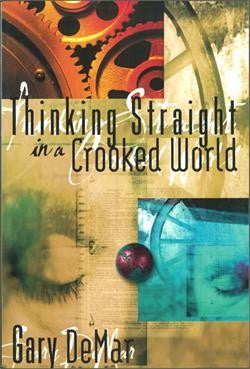Science Fiction has been defined as “Any story that argues the case for a changed world that has not yet come into being….”[1] A “changed world” means a temporary suspension of belief in what we know to be true to allow for the possibility of extraordinary occurrences that cannot happen in terms of our present operating worldview. Good science fiction blurs the distinction between the worlds of make-believe and operating reality. Science Fiction works come in all types, shapes, and forms.
Science fiction—whether books or movies—can be cautionarily prophetic as in Aldous Huxley’s Brave New World (1932), George Orwell’s Nineteen-Eighty Four (1948), and the film version of Pierre Boulle’s Planet of the Apes (1968), which is very different from the novel. They can also be technologically visionary as in Fritz Lang’s Metropolis (1926).

Using Classic Films to Teach the Christian Worldview
In this talk, Gary DeMar makes the point that classic movies are excellent teaching tools for a Christian worldview—for children and adults. Classic movies are often heavily dialogue-based, which provides a necessary counterpoint to the visually stimulating and soundbite-driven modern method of moviemaking. Real life is about real conversations, and classic movies provide a great virtual training ground for thinking and living in the real world of ideas and consequences.
Buy NowThen there are the adventure yarns coupled with futuristic storylines. Buck Rogers, based on the comic strip Buck Rogers in the 25th Century, and Flash Gordon (1936, 1980) are representative of this genre. While Star Wars (1977) tells a tale of a universe “long, long ago,” the feel is still optimistically futuristic. These types of films can be seen in the “space art” of architect and painter Chesley Knight Bonestell Jr. whose “image of Saturn seen from its giant moon Titan (the image is above), has been called ‘the painting that launched a thousand careers.’ Wernher von Braun wrote that he had ‘learned to respect, nay fear, this wonderful artist’s obsession with perfection. My file cabinet is filled with sketches of rocket ships I had prepared to help in his artwork—only to have them returned to me with…blistering criticism.’” (Source).
Some themes in SciFi dramas are dark and nihilistic as in Bladerunner (1982),[2] Alien (1979), The Terminator (1984), and the Mad Max trilogy (1980). Utopia is a forgotten myth. The goal is to survive.
Science Fiction also has its horror genre that often couples elements of legitimate science with the occult, alchemy, and evolution. I do not mean the slasher and slice-and-dice variety that had their beginning in the 1960s with the low-budget “classic” Night of the Living Dead (1968) filmed in Pittsburgh, Pennsylvania. The earliest horror or “monster movies” relied on science that had gone awry, either by miscalculation or by the cool determination of a scientist who wanted to stretch the limits of scientific convention like Wells’ The Invisible Man. Works of literature were put on the big screen, significantly modified from the original story. Mary Shelley’s Frankenstein (1931) and Bram Stoker’s Dracula (1897) are good examples of this genre. The Mummy (1932), with no literary equivalent, was a Hollywood creation probably inspired by the discovery of the tomb of Tutankhamen in 1922.
These early horror films did more than scare their audiences. They tinkered with our philosophical and religious perceptions of reality. Frankenstein is described in the subtitle by Shelley as a “Modern Prometheus.” The Greek god Prometheus is “credited with the creation of humanity from clay, and who defies the gods by stealing fire and giving it to humanity as civilization.” Rationalism was flexing its muscle in the nineteenth century and Shelley’s novel exploited the theme to its fullest.
[T]he recent controversies over creationism versus evolution overlook the central point: that the most potent creation myth of modern times is not Genesis or Darwin but Frankenstein…. [T]he Frankenstein tradition took shape in the nineteenth-century struggle between Scripture and science, romanticism and rationality.[3]
In the Frankenstein myth, man has a hand in creation, a significant departure from the Bible where God is the Creator and evolution where the magic of chance somehow creates life out of nothing.. These mad scientists saw themselves as titans—a new breed of gods—creating men and women in their image. In the superior sequel, The Bride of Frankenstein (1935), Ernest Thesiger, playing Dr. Pretorius, confirms our suspicions as he toasts, “To a new world of gods and monsters!” Dracula hopes to live forever on the blood of his victims—“Darwin dancing with Dante, as it were.”[4] Eternal life is in the blood of the soon-to-be living dead. Today, man continues to create in his twisted image where women can become men and men women and anything and everything in between.
The unnamed Frankenstein monster got it right when he declared a fitting end to this new world of fake gods and hideous monsters when he declared “We belong dead” and then blew up the laboratory where science tried to create new men and women in man’s image.
[1]John Clute, Science Fiction: The Illustrated Encyclopedia (New York: Dorling Kindersley, 1995), 6.
[2]“The film is set in the industrial wasteland of Los Angeles in the year 2019, on an Earth that is in physical and psychological decay-without a trace of nature. In the opening, panoramic long shot, fire belches out of oil refinery towers in the industrial overgrowth. Futuristic vehicles cruise through the darkened, polluted sky where the sun doesn’t shine. A huge, disembodied eye stares unblinkingly at the city stretched before it, reflecting back the city and a fiery smokestack in its clear surface.”
[3]David J. Skal, Screams of Reason: Mad Science and Modern Culture (New York: W. W. Norton and Co., 1998), 33.
[4]Skal, Screams of Reason, 81.

Thinking Straight in a Crooked World
Gary DeMar shows the power of biblical thinking and the desperate need for it in the church today. Thinking Straight in a Crooked World is designed to identify the bends in the road of ideas and repair them with biblical, straight thinking.
Buy Now
